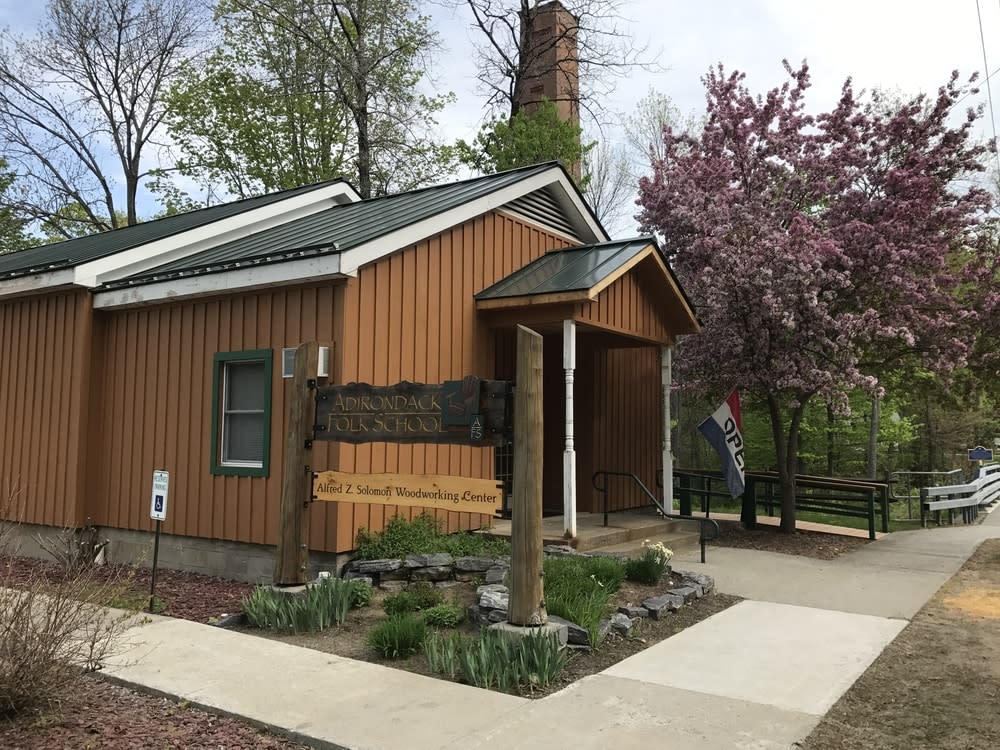
The rustic Adirondack-style building sits near the edge of Main Street alongside the fast-running waters of Stewart Brook as it channels its way south to connect Lake Luzerne with the Hudson River. It is an idyllic setting for the learning that goes on inside the quaint structure, now known as the Adirondack Folk School.
The nearly 110-year-old building located at 51 Main Street in the tiny Adirondack town of Lake Luzerne wasn’t always a learning center for people interested in resurrecting the crafts and arts that are an integral part of our American cultural heritage. After serving residents for many years as the Luzerne Town Hall, it was standing vacant in 2008 when longtime resident, Jim Mandle, proposed to the town that it be turned into a folk school.
Mandle is a familiar figure in and around Luzerne. Six generations of his family have made Lake Luzerne their summer home, and when he was asked by the town supervisor to be part of a master committee charged with finding a new resident for the vacant building, he readily agreed.

For centuries, Europeans arrived on the shores of North America. The lush wilderness and the crystalline waters of Luzerne were home to many groups of Native Americans who lived and hunted in the area. By the late 1700s, the Adirondacks had become a hub for tanneries, grist and paper mills, hunters and trappers. The 1800s saw the creation of the nation's first campgrounds and Great Camps, rapidly turning the area into a mecca for people traveling from the cities to take in the Adirondacks' crisp, healing air and pristine waters. People suffering from tuberculosis traveled further north to hotels and sanitariums to partake in the clean air that was thought to cure the disease.

By the 1930s many of the hotels that had sprouted in the region were turned into dude ranches, attracting city dwellers looking for a wilderness experience. However, by the late 1970s, dude ranches were becoming a thing of the past, with people wanting a more varied vacation experience.
More and more people were looking for authentic experiences that would both enlighten and enrich their appreciation of a region. In different parts of the country, the European tradition of the folk school was beginning to take hold. With its roots in Denmark dating to the 1800s, the goal of the folk school tradition is to instill a lifelong love of learning and a pride in one’s cultural heritage. From its early beginnings, the folk school teachings were designed to bring a sense of dignity to members of rural and farming communities.

When Mandle made a canoeing trip with some buddies shortly after joining the town’s committee, he discovered one such folk school located along the shores of Lake Superior. The North House Folk School in Grand Marais, Minnesota is committed to teaching traditional crafts that provide a powerful bond between people and resources, while also connecting the past to the present and the future.
He was completely taken with the place and thought the concept would work great in Lake Luzerne.
Not only would it be a wonderful way to preserve and grow the rich cultural and artisanal heritage of the Adirondacks, it would also be a great way to bring more people into the tiny downtown area.
Jim thought it would be “neat to have a school that taught traditional arts and crafts, with no pressure to compete. It’s just the pure pleasure of learning a skill and working with your hands.”
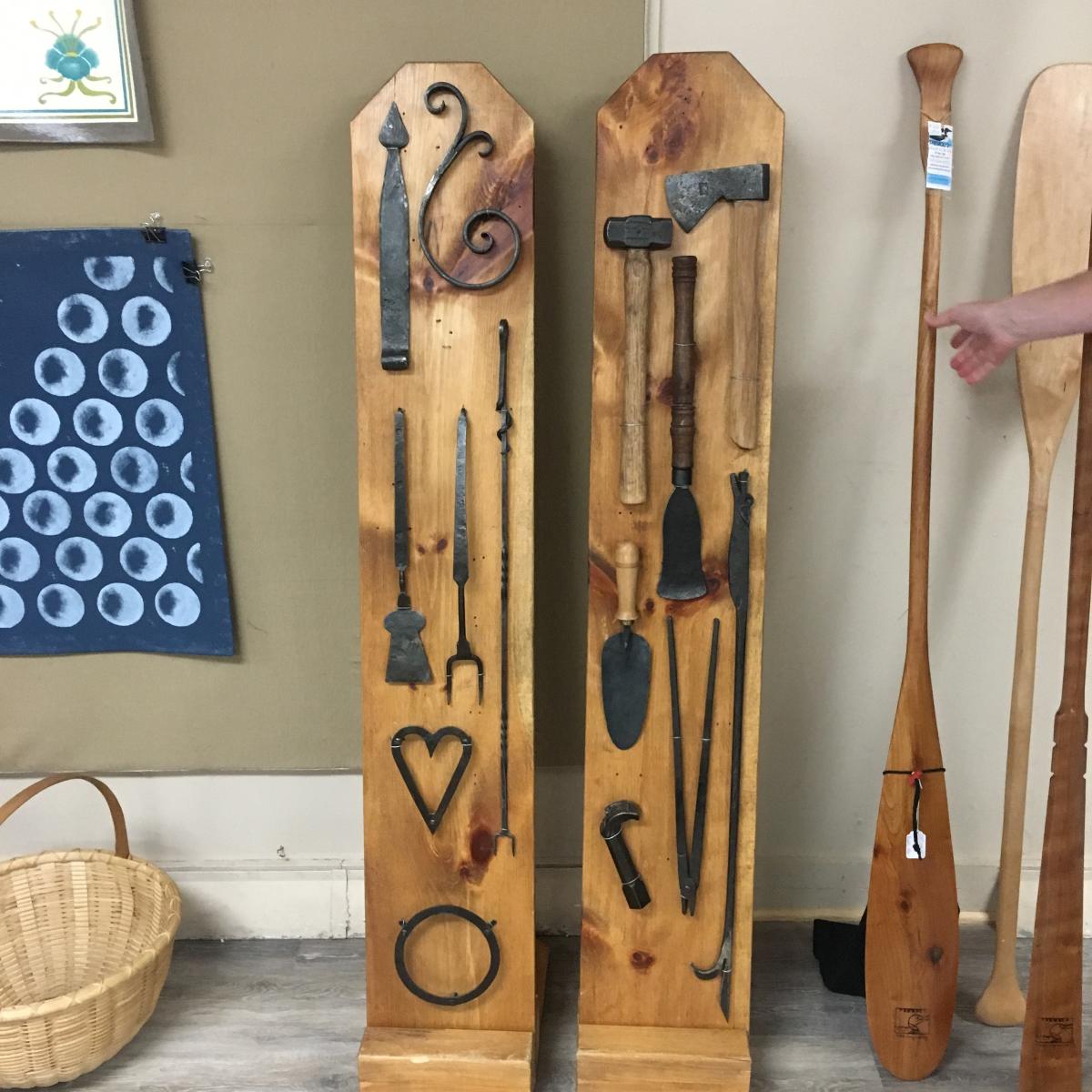
He did his research, learning all about the tradition of the folk school and the kinds of resources that would be necessary to put a school together in Lake Luzerne. Then he made his proposal to the town board.
They loved the idea and gave it their full support.
“I started a 501c3 and from there it took off," Mandle explains. "The town rented the building to us for one dollar and the following day we put up a sign and started painting, cleaning and finding equipment and tools for the classes we would offer.”
That was in February 2010 and in June they began teaching their first classes.
In the ten years since it opened, the Adirondack Folk School has undergone major renovations and weathered its share of ups and downs. Today, it is on firm footing and fast making a name for itself – nationally and internationally – as a bona fide center of cultural arts, learning and preservation of rich traditions that might otherwise fade into obscurity.
It has also been a boon to the small but vibrant downtown area, as well as to the many artisans and craftsmen and women who live in the surrounding region and beyond.
Mandle tells the story of their initial attempts to find instructors for their fledgling school.
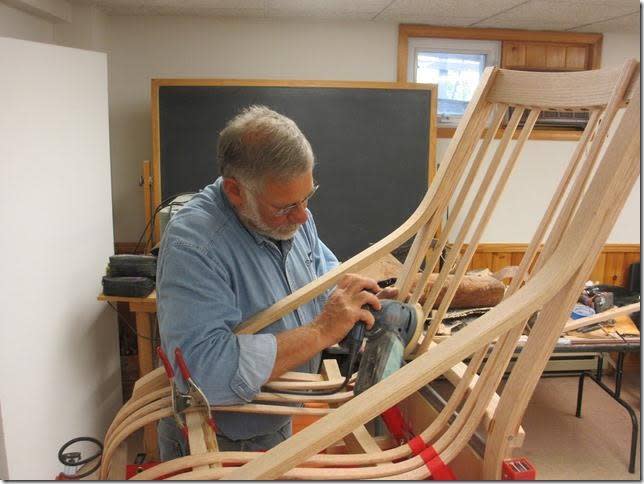
“We came up with the idea of a ’50 /50,’” he recalls, explaining that the numbers referred to finding 50 artisans within a 50-mile radius. “We hosted a wine and cheese party and invited artists and craftspeople from the surrounding area. They loved the idea of the school and many of them initially taught for free, just to help things get started.”
Ten years later, Adirondack Folk School attracts both students and instructors from across the country and around the globe.

Scott Hayden, who came on board as the school’s Executive Director in 2016, is excited about the school’s rapidly growing reputation in the upstate region and beyond. Under his careful guidance and watchful eye, the school has seen an uptick in enrollment and number of classes being offered.
“When the school first opened in 2010, we offered 90 classes. This year (2018) we had 259,” says Hayden, adding that they have seen a 40 percent growth in student enrollment in the past year, with another 20 percent increase expected for the 2018 season.
Those classes range from soap-making, wood-carving and birch bark picture frames, to furniture-making, basket-weaving and blacksmithing. Tucked in between those categories are courses in fly-tying and casting, survival skills training and even things as simple and gratifying as educational nature walks and Adirondack photography.
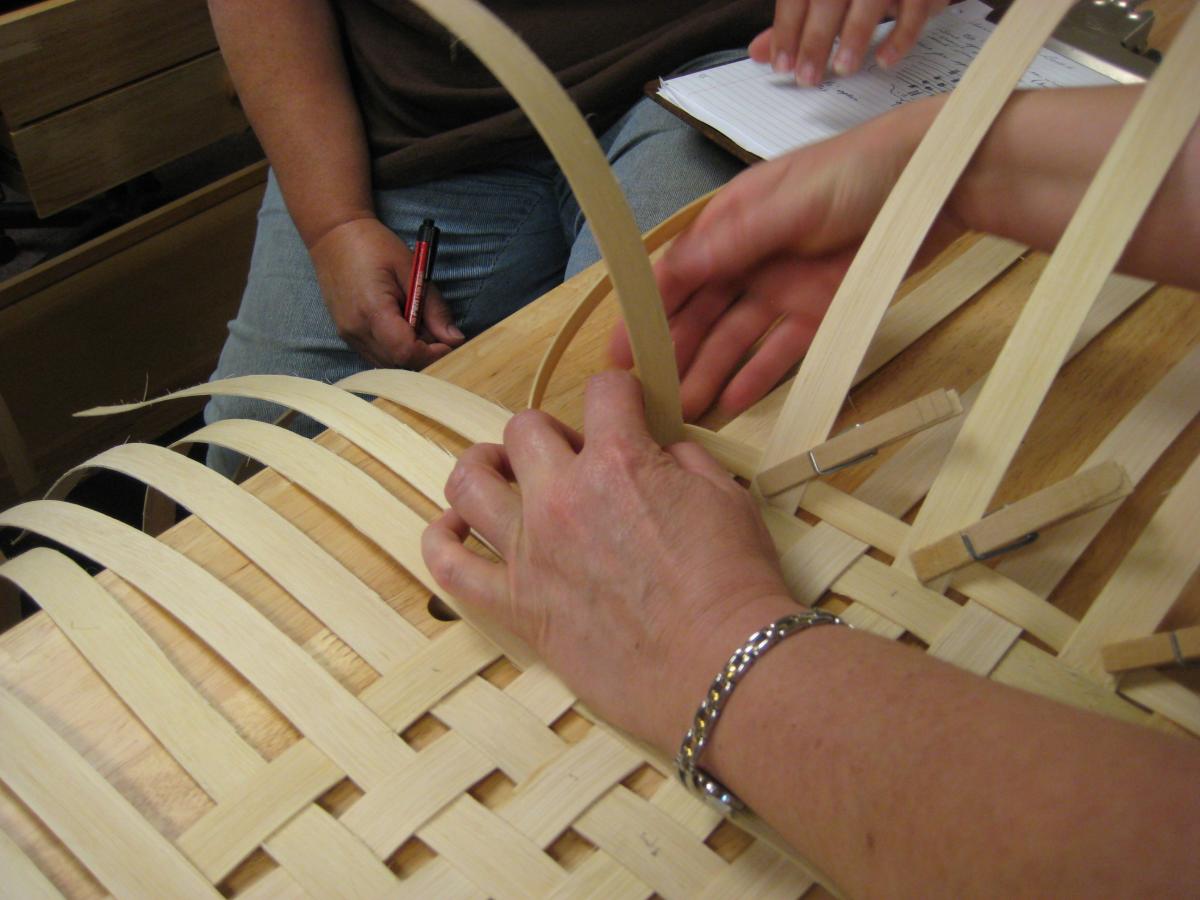


The beauty of the school, says Hayden, is that absolutely no skill is required to participate in a class. Thanks to a pool of instructors who are among some of the top artisans and craftsmen and women in the country, students come to a class hoping to build an Adirondack-style chair or fashion a pair of one-of-a-kind earrings, and they leave satisfied, with a beautiful product.

The instructors are a key factor in the continuing success and growing renown of the Adirondack Folk School. One of the most popular draws is the blacksmithing curriculum. With nine forges and authentic equipment that resembles something straight out of historic Williamsburg or Sturbridge, first-time forgers or advanced smiths can take advantage of classes that not only develop their skills for the craft, they also increase their appreciation of it as an art to be perpetuated.

As I wander through the Hand, Hearts, Mind Pavilion, which sits just behind the main building, I am in awe of the quantity and variety of handmade tools. You see, blacksmiths don’t just make iron fences and wall sconces, they also make the tools which they use to forge all those other items.

The blacksmiths come from, quite literally, near and far and is a veritable “Who’s Who” of master craftsmen. Dick Sargent, who lives in East Dover, Vermont, is one of those masters. He has been smithing for nearly 50 years, having worked in Sturbridge and then in Newport, Rhode Island, where he worked in conjunction with the Newport Restoration Foundation, creating the iron railings and hardware for more than 50 historic homes and estates in the Newport area.
Sargent first became involved with Adirondack Folk School about three years ago. He had been the head of a blacksmithing department for ten years at the Peters Valley School of Craft in New Jersey. When he returned to Vermont to live, he crossed paths with Jim Mandle at a blacksmith meet. Mandle asked him if he was interested in teaching at the school and the rest is history.
“It’s been amazing. I’ve taught at a number of other schools, and the shop at Adirondack Folk School is the best-equipped blacksmith teaching facility I’ve ever been to. It has everything you need in order to teach a class. A lot of other schools have stuff you’ll never use as an instructor. And they don’t have the things you really need to teach basic blacksmithing. Here, they did it just right.”
Sargent says has done 18th century reproduction ironwork for most of his career.
“It’s like being an industrial archaeologist. None of the methods used by blacksmiths of that period were recorded, so you spend a lot of time trying to figure things out. You try to determine how something was made and you re-discover their methods and reproduce them in your own work. The investigative work is what I love the most.”
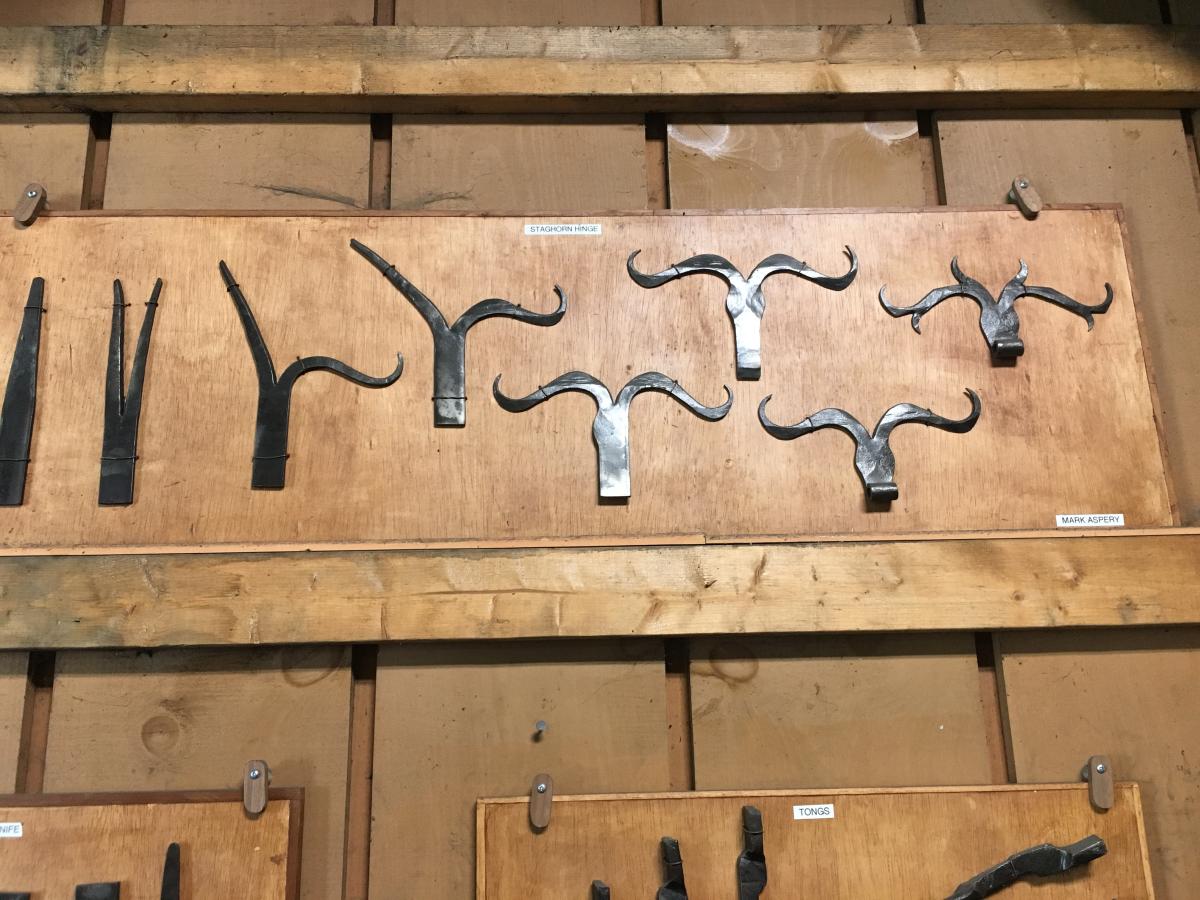
The teaching part probably comes in at a close second for Sargent. He is energized and intrigued when he has a room full of students eager to learn. “I love seeing it when that light bulb comes on in their heads and they figure out how to do something.“


Other blacksmiths who regularly teach here are Peter Ross, who is probably one of the most respected masters of his craft in the country. Ross served as Master of the Blacksmith Shop in historic Williamsburg, Virginia for 25 years. Another master, Derek Heidemann, is the “youngster” of the group. He became an apprentice at just 14, studying and working at the Moses Wilder Blacksmith Shop in Old Sturbridge Village. In 2011, he founded Resurrection Iron Works, where he creates traditional iron pieces for museums, schools, and for the public. His work is on display at nearby Fort Ticonderoga, Genesee Country Village & Museum, the USS Constitution Museum, and many other locations.
Another popular component of the school’s curriculum is basket-weaving. Barbara Boughton is one of several instructors who teach regularly there. Boughton’s family has a long history in the region and, after studying art at the University of New Hampshire and photography at the University of California, San Francisco, she returned to live in the homestead of her great grandparents and immersed herself in learning the “old ways” of doing things. A basket weaver and fiber artist, Boughton’s work focuses on the relationship between form and function, while also incorporating the graceful lines of the Shakers with the fluidity of twill patterns.

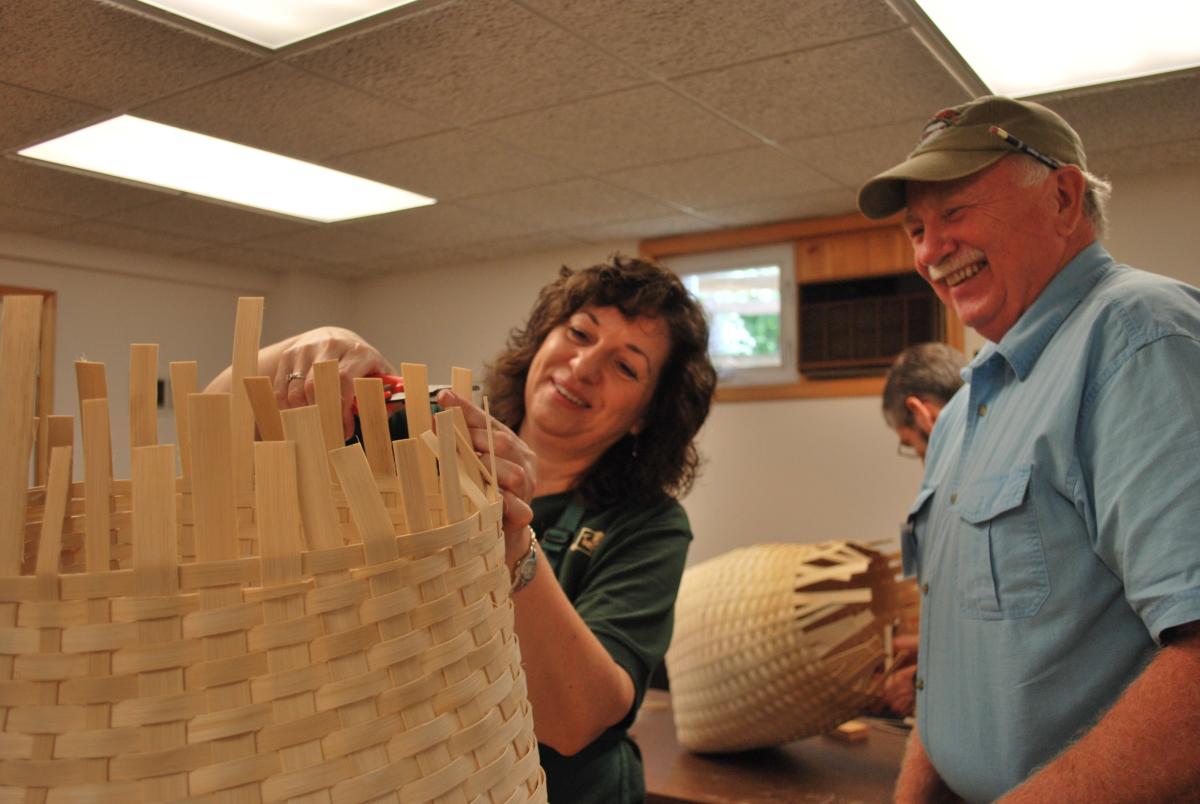
As a student of the world-renowned Russian basket weaver, Vladimir Yarish, Barbara was successful in bringing Yarish as a guest instructor to the school this past June. There are literally no other places in this part of the country where people interested in learning these skills can learn from true masters of their crafts.
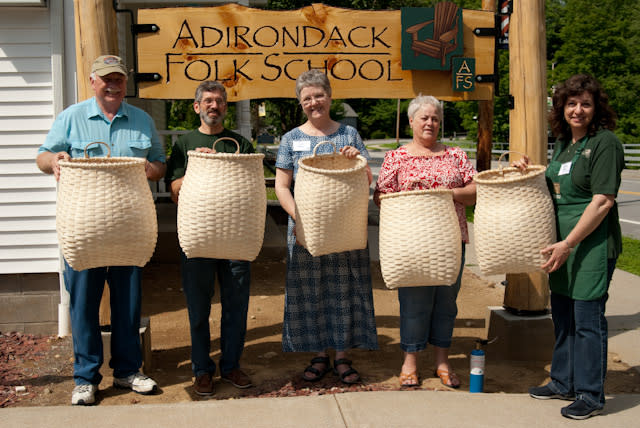
In talking with students of the school, the message is the same: there is quite literally, no other place like the Adirondack Folk School in the Northeast. Most of the people I’ve spoken with have started out taking a class that they’ve always been interested in, only to keep coming back and expanding their crafting horizons by taking more classes.


One student, Bob English, lives in Saratoga Springs but, like Jim Mandle, there are five generations of Englishs occupying 14 different camps clustered around Lake Luzerne. For a Brooklyn boy, English says he felt like he died and went to heaven the first time he came here – and it’s been that way ever since. He even named his video and television production company Luzerne Productions, after his favorite getaway.
English has known Mandle for years and when the school first opened, he decided that he would try his hand at making an Adirondack-style headboard. Working with Jim Schreiner, a well-respected furniture-maker and owner of Great Sacandaga Designs, English was able to fashion the headboard he had seen for sale at a local shop for more than $2,000.
“It was a challenge for us both,” he said. “But Jim was a wonderful and extremely patient teacher and we got it done in two days.”

Since then, English has returned to the school, learning how to make baskets, Adirondack-style lampshades and birch bark picture frames. “I’d take more classes in a heartbeat,” he says, adding that people come to the village now from all over just to take part in classes. “It’s been a real shot in the arm for the town and for local businesses.”

Schreiner agrees that the school has been wonderful for the village.
“For every dollar spent at the Folk School, about $15 is spent in the community. They get gas, they eat at the Up River Café, Hadley Deli, pizza places, and they stay at local motels. The school helps everybody,” says Mandle, including the instructors, who earn money for teaching, while also enhancing their own businesses.
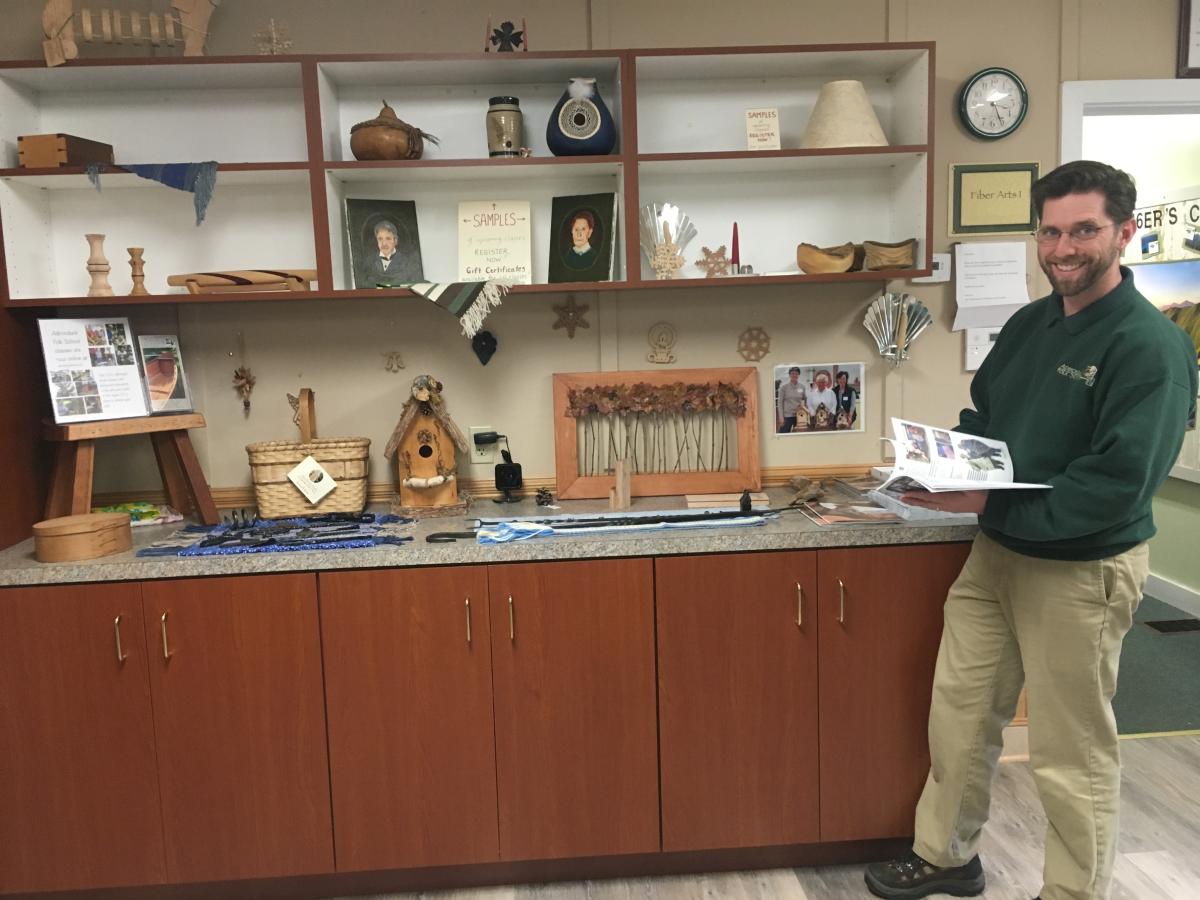

And of course, for Hayden, there’s nothing better than taking a few moments in the middle of a busy day to wander outside and take in the bubbling waters of the nearby stream when he needs a tranquil moment away from his duties. “There’s just nothing quite like it.”
For more information about the Adirondack Folk School and to enroll in a class, access their website, www.adirondackfolkschool.org.
